Digital Poster
What's the Next Step in Breast MRI
ISMRM & ISMRT Annual Meeting & Exhibition • 10-15 May 2025 • Honolulu, Hawai'i

 |
Computer Number: 17
1974. Multi-shot
EPI and deep learning reconstruction: Clinical utility in breast
DWI
D. Biswas, V. Park, D. Hippe, D. Turley, K. Widner, T.
Yangchen, I. Li, M. Bryant, J. Peeters, H. Rahbar, S.
Partridge
University of Washington, Seattle, United States
Impact: This study demonstrated that multishot EPI
breast DWI can significantly reduce geometric distortions
and potentially improve lesion conspicuity over single-shot
EPI DWI, especially using an AI based reconstruction
technique to increase spatial resolution without adding to
scan time.
|
|
 |
Computer Number: 18
1975. Diagonal
DWI: A Time-efficient Alternative to 3-scan Trace DWI for Breast
Lesion Evaluation at 3.0T - Phantom Study and Clinical
Assessment
Y. Jo, M. Iima, Y. Kato, Y. Zhang, H. Satake, Y. Sato, K.
Ichikawa, S. Ishigaki, R. Hyodo, Y. Ichiba, S. Naganawa
Nagoya University Graduate School of Medicine, Nagoya, Japan
Impact: This study demonstrates diagonal DWI as a
time-efficient alternative to traditional DWI in breast
imaging protocols, potentially improving clinical workflow
while maintaining diagnostic accuracy.
|
|
 |
Computer Number: 19
1976. The
Effect of Model-Based Bolus Arrival Time on Quantitative DCE
Parameters and Prediction of Breast Cancer Therapy Response: A
Preliminary Study
B. Moloney, A. Tudorica, D. Biswas, A. Kazerouni, J. Holmes,
S. Partridge, W. Huang, X. Li
Oregon Health & Science University, Portland, United States
Impact: Use of model-based BAT at voxel level for
DCE-MRI PK modeling may potentially improve accuracy of
estimated Ktrans and
its predictive performance for NAC response.
|
|
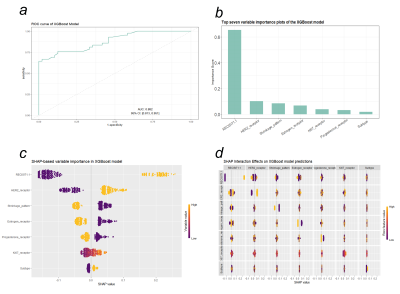 |
Computer Number: 20
1977. Preoperative
Prediction of Pathological Complete Response in Breast Cancer
Treated with Neoadjuvant Chemotherapy: A Longitudinal MRI Study
M. Tang, J. Liu, D. Chen, J. Zhang
Department of Magnetic Resonance, The Second Hospital & Clinical Medical School, Lanzhou University, Lanzhou, China
Impact: We proposed a novel model based on longitudinal
MRI data to predict pCR to NAC in breast cancer, including
both mass and non-mass enhancement lesions, to inform
personalized clinical treatment plans.
|
|
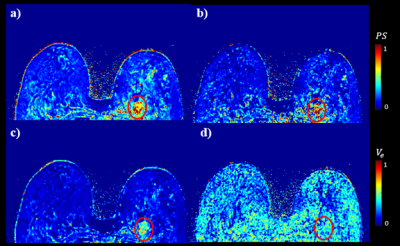 |
Computer Number: 21
1978. Fluid
mechanics based quantitative transport mapping network (QTMnet)
for predicting treatment response of breast cancer from DCE MRI
Q. Zhang, D. Romano, R. Hu, B. Weppner, T. Nguyen, P.
Spincemaille, Y. Wang
Weill Cornell Medicine, New York, United States
Impact: QTMnet can be coupled into clinical breast
cancer practice to predict treatment response.
|
|
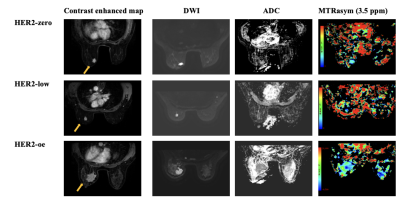 |
Computer Number: 22
1979. The
value of APT weighted imaging in differentiating breast cancer
patients with HER2 zero-, low- and over-expressing
T. Zhan, J-k Dai, Q-q Wen, C-h Lu
Department of Radiology, The Second Affiliated Hospital of Nanchang University, Nanchang, China
Impact: APTWI could be used as non-invasive biomarker
for identifying HER2-zero,HER2-low, and HER2-oe. The
application of APTWI would be beneficial for guiding
treatment selection and dynamically monitoring HER2
expressing level throughout the course of treatment for BC
patients.
|
|
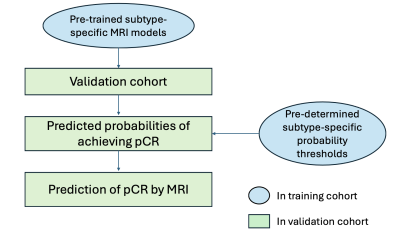 |
Computer Number: 23
1980. Validation
of an MRI-Based Predictive Model for Treatment Tailoring in the
I-SPY 2 Trial
W. Li, J. Gibbs, N. Le, P. Metanat, M. Gibbons, T. Bareng,
N. Onishi, L. Wilmes, E. Price, B. Joe, J. Kornak, C. Yau,
D. Wolf, M. J. Magbanua, S. Venters, B. LeStage, L. van 't
Veer, A. DeMichele, L. Esserman, N. Hylton
University of California, San Francisco, San Francisco, United States
Impact: This is the first study of MRI-based predictive
models that were developed and validated using two separate
large cohorts from a multicenter neoadjuvant chemotherapy
clinical trial.
|
|
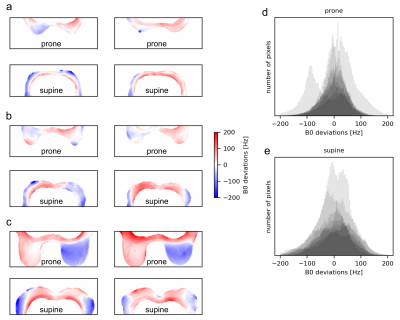 |
Computer Number: 24
1981. Characterizing
B0 field inhomogeneity, B1+ variations, and respiratory motion
for breast MRI in the supine position
J. Zimmermann, B. Daniel, B. Hargreaves, C. Moran
Stanford University, Stanford, United States
Impact: In supine breast MRI, B0 inhomogeneity and B1+ variations
and respiratory-induced motion all increase, posing new
technical challenges that must be addressed for robust
supine breast imaging, and to ultimately overcome
limitations of standard-of-care prone imaging.
|
|
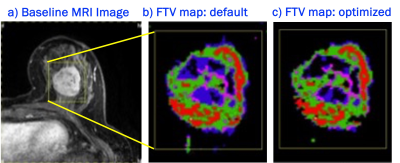 |
Computer Number: 25
1982. Functional
Tumor Volume by Subtype Improves Prediction of Pathological
Complete Response in Breast Cancer
M. Gibbons, W. Li, N. Le, J. Gibbs, T. Bareng, N. Onishi, L.
Wilmes, E. Price, B. Joe, J. Kornak, C. Yau, D. Wolf, M. J.
Magbanua, B. LeStage, J. Perlmutter, D. Yee, W. Symmans, H.
Rugo, R. Shatsky, C. Issacs, I-S Investigator Network, I-S
Imaging Working Group, L. van 't Veer, A. DeMichele, L.
Esserman, N. Hylton
University of California, San Francisco, San Francisco, United States
Impact: In the breast cancer I-SPY2 clinical trial,
better pathological complete response (pCR) prediction would
lead to improved treatment redirection and treatment
sparing, improving patient outcomes. In this study, we
optimized parameters for MRI functional tumor volume
calculation to improve predictions.
|
|
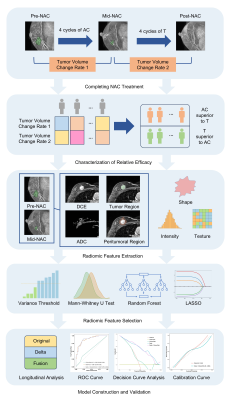 |
Computer Number: 26
1983. Predicting
Relative Efficacy of Anthracyclines vs. Taxanes in Breast Cancer
NAC with a Longitudinal MRI Radiomics Model
K. Liu, R. Zheng, J. Wang, S. Wang
Department of Radiology, the First Affiliated Hospital of Nanjing Medical University, Nanjing, China
Impact: Our
radiomics models underscored the value of multi-region,
multi-sequence MRI data in longitudinal monitoring during
neoadjuvant chemotherapy (NAC), revealing the potential to
guide personalized NAC regimens for patients. It is
necessary to confirm this potential through prospective
comparative studies.
|
|
 |
Computer Number: 27
1984. R2*
MRI for Early Prediction of Neoadjuvant Chemotherapy Response in
Breast Cancer Synopsis
J. Yu, S. Du, H. Guan, L. Zhang
The Fourth Affiliated Hospital of China Medical University, Shenyang, China
Impact: This research highlights R2* values from
IDEAL-IQ MRI as valuable, early biomarkers for breast cancer
chemotherapy response, potentially guiding clinical
decisions, enhancing personalized treatment approaches, and
contributing to better patient outcomes by reducing
unnecessary or ineffective therapies.
|
|
 |
Computer Number: 28
1985. Radiomics-Based
Multiparametric MRI for Differentiating Luminal A and Luminal B
Breast Cancer: A Multi-Center Study
H. Zhou, D. y. Yang, X. c. Zeng, X. d. Liu, L. Wei
The Affiliated Jinyang Hospital of Guizhou Medical University, gui yang, China
Impact: This study enhances breast cancer diagnosis by
providing a noninvasive method to differentiate Luminal A
and Luminal B subtypes. This could potentially improve
clinical decision-making and enable personalized treatment
plans for patients.
|
|
|
Computer Number:
1986. WITHDRAWN |
||
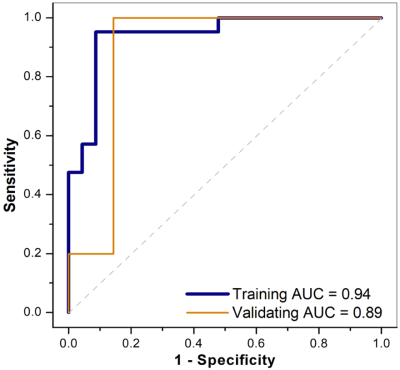 |
Computer Number: 29
1987. Cluster
analysis of quantitative ultrafast DCE-MRI for prediction of
breast cancer response to neoadjuvant chemotherapy
Z. Ren, X. Fan, F. Howard, R. Nanda, H. Abe, K. Kulkarni, N.
Chen, A. Biernacka, G. Karczmar
University of Chicago, Chicago, United States
Impact: K-means clustering analysis of ultrafast DCE-MRI
is a stable technique to effectively predict treatment
response in breast cancer patients prior to neoadjuvant
chemotherapy, which facilitates personalized therapy
adjustments and can improve clinical outcomes through
individualized treatments.
|
|
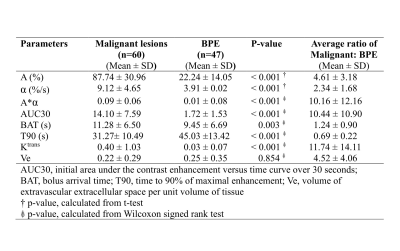 |
Computer Number: 30
1988. Initial
Experience and Clinical Application of Gadoterate Meglumine in
Abbreviated DCE-MRI of the Breast with Ultrafast Imaging.
S. Chumsaengsri, K. Kulkarni, Z. Ren, H. Abe, G. Karczmar
University of Chicago, Chicago, United States
Impact: Ultrafast imaging (3.5–4.6 seconds) yields
benefit individuals with preserved diagnostic accuracy for
breast cancer detection. Furthermore, lower signal
enhancement of background parenchyma by using gadoterate
meglumine may help for lesion detection in screening
settings, particularly in young or premenopausal women.
|
|
 |
Computer Number: 31
1989. Predicting
HER-2 Expression in Breast Cancer Using MDME-Based T1 and T2
Mapping Combined with DWI
Y. Zhou, J. Li, M. Chen, N. Zhou, Y. Wang, Y. Zeng, Y. Lu
Medical imaging department,First Affiliated Hospital of Kunming Medical University, Kunming 650000, China
Impact: MDME-based T1 and T2 mappings combined with DWI
offers a rapid, non-invasive method for predicting HER-2
expression in breast cancer, potentially reducing the need
for biopsy and supporting preoperative decision-making.
|
The International Society for Magnetic Resonance in Medicine is accredited by the Accreditation Council for Continuing Medical Education to provide continuing medical education for physicians.